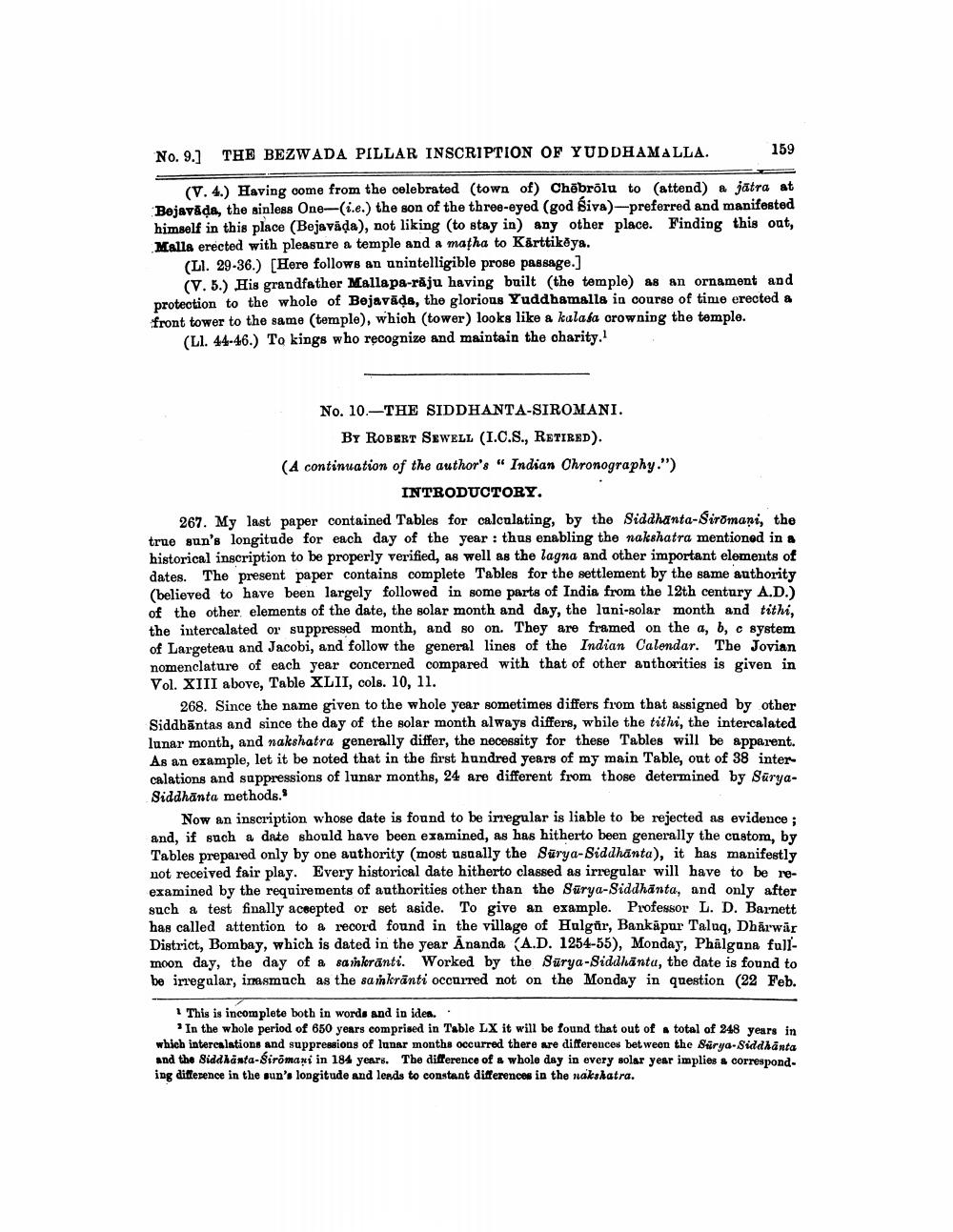________________
No. 9.) THE BEZWADA PILLAR INSCRIPTION OF YUDDHAMALLA.
159
(V. 4.) Having come from the celebrated (town of) Chõbrölu to attend) a jātra at Bejavāda, the sinless One-(i.e.) the son of the three-eyed (god Biva)-preferred and manifested himself in this place (Bejavăda), not liking (to stay in) any other place. Finding this out, Malla erected with pleasure a temple and a matha to Karttikoya.
(LI. 29-36.) Here follows an unintelligible proge passage.]
(V.5.) His grandfather Mallapa-rāju having built (the temple) as an ornament and protection to the whole of Bejavāda, the glorious Yuddhamalla in course of time erected a front tower to the same (temple), which (tower) looks like a kalaba crowning the temple.
(Ll. 44-46.) To kings who recognize and maintain the charity.1
No. 10.-THE SIDDHANTA-SIROMANI.
BY ROBERT SEWELL (I.C.S., RETIRED). (A continuation of the author's " Indian Chronography.")
INTRODUCTORY. 267. My last paper contained Tables for calculating, by the Siddhanta-Siromani, the true gun's longitude for each day of the year : thus enabling the nakshatra mentioned in a historical inscription to be properly verified, as well as the lagna and other important elements of dates. The present paper contains complete Tables for the settlement by the same authority (believed to have been largely followed in some parts of India from the 12th century A.D.) of the other elements of the date, the solar month and day, the luni-solar month and tithi, the intercalated or suppressed month, and so on. They are framed on the a, b, c system of Largeteau and Jacobi, and follow the general lines of the Indian Calendar. The Jovian nomenclature of each year concerned compared with that of other anthorities is given in Vol. XIII above, Table XLII, cols. 10, 11.
268. Since the name given to the whole year sometimes differs from that assigned by other Siddhāntas and since the day of the solar month always differs, while the tithi, the intercalated lunar month, and nakshatra generally differ, the necessity for these Tables will be apparent. As an example, let it be noted that in the first hundred years of my main Table, out of 38 intercalations and suppressions of lunar months, 24 are different from those determined by SuryaSiddhānta methods.
Now an inscription whose date is found to be imegular is liable to be rejected as evidence ; and, if such a date should have been examined, as has hitherto been generally the custom, by Tables prepared only by one authority (most usually the Sürya-Siddhanta), it has manifestly not received fair play. Every historical date hitherto classed as irregular will have to be reexamined by the requirements of authorities other than the Sürya-Siddhanta, and only after such a test finally aceepted or set aside. To give an example. Professor L. D. Barnett has called attention to a record found in the village of Hulgir, Bankāpur Taluq, Dharwar District, Bombay, which is dated in the year Ananda (A.D. 1254-55), Monday, Phalgana fullmoon day, the day of a samkrānti. Worked by the Sürya-Siddhānta, the date is found to be irregalar, inasmuch as the sankranti occurred not on the Monday in question (22 Feb.
1 This is incomplete both in words and in idea..
In the whole period of 650 years comprised in Table LX it will be found that out of a total of 248 years in which intercalations and suppressions of lunar months occurred there are differences between the Sürya-Siddhanta and the Siddhanta-Siromani in 184 years. The difference of a whole day in every solar year implies & correspond. ing difference in the sun's longitude and leads to constant differences in the nakshatra.




